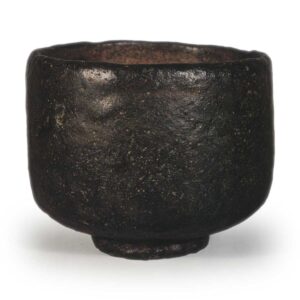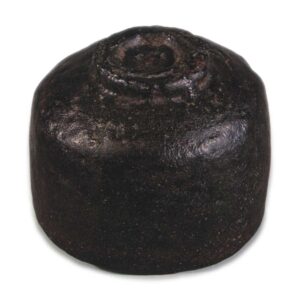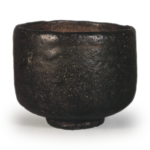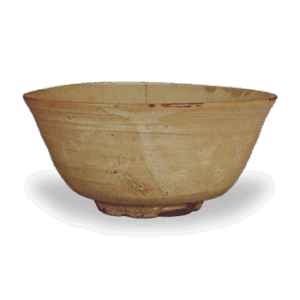

Collection: Fujita Museum of Art
Height: 8.2-8.6cm
Diameter: 10.2cm
Foot diameter: 4.8-5.0cm
Height: 0.7-0.8cm
This is also known as the “Iris” (Iris) with the same Sotatsu signature, and as the “Iris” is similar in appearance to the “Iris”, it is named after the “Iris” (Iris) and given the name “Makomo” (True cattail).
The shape is similar to that of Chojiro’s works, and the overall shape is thick and chunky, with the rim slightly curved inwards, and a bulge in the middle of the inside circumference, like a waistband. The rim is high and low, but has a natural charm. The exterior is uneven in texture, and the glaze is not glossy, so-called “glaze skin”, and in addition, the iron glaze promised by Chojiro is beautifully colored on the inside, presenting a tea glaze skin, and the overall facial expression is even more profound in its taste of contempt. The foot ring is more robust than that of a normal Chojiro, and the glaze on the sides adds a further sense of wabi. The foot ring is shaped like a swastika, and there is a lacquered repair on the foot ring rim.
The name “Makomo” was given by Sōtan, and compared to the Iris, it is a name that is even more suited to the wabi-sabi aesthetic, and it is a name that allows us to fully appreciate Sōtan’s suki-gokoro (aesthetic sensibility). Incidentally, Makomo is one of the seven types of tea bowls made by Chōjirō, and it is one of the 40 bowls with Sōtan’s name on them.
The accompanying items are
Inner box: paulownia wood with white lacquer, with a calligraphy inscription on the lid by Sotatsu “Makomo
Same as above, with a calligraphy inscription on the lid by Sotatsu ‘Dan (signature)’
Middle box: black lacquer, with a calligraphy inscription in red lacquer on the lid by Kusumi Sōan ”Makomo Chōjirō ware
Inside the lid: “Ayame Makomo Ni-tsu no Chawan (Ayame and Makomo Two-handled Tea Bowl) Owned by Hachisen Sōtan. Ayame owned by Hachisen Sōmori. Transmitted from Sōtan to Nakamura Sōtetsu, and from Sōtetsu to this place. Meireki Tōyu (3rd year)”
Outer box: paulownia wood, lid: “Rikyu’s possession, black tea bowl made of makomo”
Inside lid: “Rikyu’s possession, black tea bowl made of makomo, May 12th, 1707, from Kusumi Sōan to this place, Ehara”
Attached note: three copies
It was originally owned by Rikyu and passed on to Sen Sōtan, and then to the lacquerer Nakamura Sōtetsu. In 1656, it was passed on from Sōtetsu to Kusumi Sōan, and in 1707, Sōan passed it on to Zeniya Ehara Chūshichi of Kyoto. In 1737, it passed from the same family to Yagura Yoshiichi, and later moved to Kyoto’s Yamashita Yuba, but in 1822 it passed through the hands of Osaka’s Katsubei, a dealer in tools, and then into the hands of Ihei Konoike, and later became the property of the Fujita family, and is now in the collection of the Fujita Art Museum.








